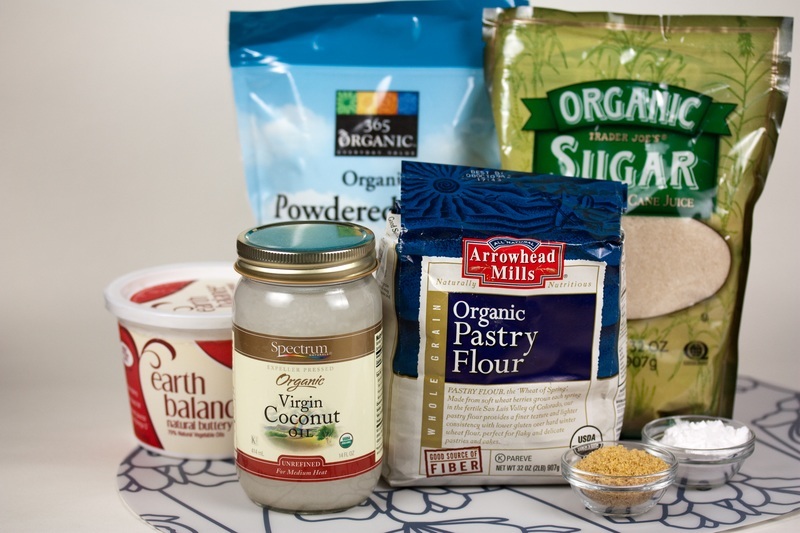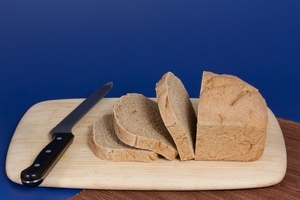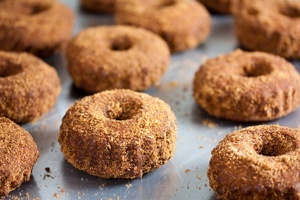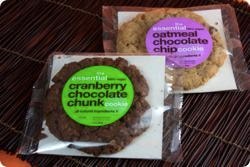Veganbaking.net
Vegan Baking Articles
Vegan Baking Guides
Useful Vegan Baking Ingredients - Make sure you have these essentials!
Useful Vegan Baking Ingredients - Make sure you have these essentials!
1
Comments (3)

How in samhain do take eggs and butter out of baked goods and still make them taste good? The study of that is why this website was created. The internet already contains a ton of information regarding regular baking ingredients so I'm not going to touch on those. There are, however, various ingredients that have helped me in my baking. Here are some that work for me.
Egg Replacers
In my experiences vegan baking or veganizing a recipe without substituting anything to bind the baked product is a gamble that usually doesn't pan out. There are many methods of binding in vegan baking recipes.Learn more about vegan egg replacers.
Egg Replacer Powder
I use Egg Replacer Powder extensively in my baking to the point of where many other vegan bakers probably roll their eyes when they see it in my recipes. There is a reason why I use it so extensively: I just haven't been able to find anything that gets closer to duplicating what an egg does. Many other people swear by things like tofu, bananas and golden flax meal whisked in water. In my experiences, tofu doesn't bind, bananas always make your baked item taste like bananas and flax meal often makes your baked items taste mealy. That doesn't mean I'm against those methods. Many vegan bakers don't like to use vegetable starches and gums like Eggless Binder Powder because they feel it imparts a chalky flavor to their recipes. As long as I use arrowroot powder and whisk the Eggless Binder Powder into a slurry in non-dairy milk or water before adding it to the wet ingredients in a recipe, I never taste chalky flavors. Some vegan bakers also like to use a less processed approach to their baking. My style is to try to duplicate the baked item consistently, conveniently and without subjecting the eater to things that are too harmful like partially hydrogenated oils. The great thing about baking is that all experiences are subjective and baking style varies from person to person. I encourage people to use what works best for them.Flax Seed Egg Replacer
Golden flax seeds can be ground in a spice grinder or blender into a 'meal' then added to warm water for a few minutes. The mixture then goopifies and is similar to egg albumen. Flax Seed Egg Replacer is recommended in recipes that aren't white; white cake will show the flax meal particles. It's important to use golden flax instead of brown flax seeds because they can impart stronger flax flavors along with their more visible darker specs.Brown Rice Syrup
Sometimes when I need extra binding power I use brown rice syrup in a recipe. This is extremely sticky stuff that gets even stickier when it's subjected to heat. It also has the benefit of being a sweetener with a slight caramel flavor that can often enhance butter flavors in recipes. This caramel flavor can also be a hindrance because usually if you add more than 2 Tablespoons of brown rice syrup to a recipe the caramel flavor starts to take over and ruin the flavors you're trying to bring out. Another issue of adding too much brown rice syrup is that if you're making light cakes it can weigh down the dough to the point of where it has rising issues and retains too much moisture.Fats
Mouthfeel is an industry term to describe, well, how the baked item feels in your mouth. When you want a rich dense dessert like a frosting or a brownie, you usually obtain that rich dense mouthfeel by using a fat that is solid at room temperature. The more solid the fat at room temperature, the more you will be able to achieve this rich dense mouthfeel.Non-Hydrogenated Tub Margarine
Non-Hydrogenated Tub Margarine is great for when you're interested in substituting butter and you want something dense like a cookie.Luckily, many margarine companies have figured out how to make margarine without using partially hydrogenated oils. At the time of this writing, partially hydrogenated oils are in many foods and slowly being phased out due to the fact that the fat is extremely unhealthy to consume. Hopefully partially hydrogenated oils will some day be completely phased out of the food supply. Please make sure the margarine you buy does not have anything similar to partially-hydrogenated in its ingredient list. Fully hydrogenated is safe because no trans fats are produced in the end product.
Non-hydrogenated margarines are also usually lower in saturated fat, which many health professionals classify as an unhealthy fat. Although unhealthy, saturated fat is still healthier than partially hydrogenated oils.
Learn how to make Vegan Butter.
Coconut Oil
Coconut oil is extremely solid at room temperature to the point of where you will have to heat the jar in order to liquify the fat for measuring. It's great for things like brownies and blondies where you want to get something extremely dense and rich. Coconut oil comes in two variants:Unrefined Coconut Oil
Unrefined coconut oil is just pure coconut oil. Since it's unrefined it's closer to it's natural state and may be healthier. It's jam packed with coconut flavor! If you're making something like regular brownies, this can be a hindrance because the coconut flavor will be very prevalent. If you're making coconut brownies, this can be great.Refined Coconut Oil
Refined coconut oil has been refined to remove any coconut flavors. Since it's been processed, it's more distant to it's natural state which may freak out health nuts. The great thing about refined coconut oil is that it's the be all end all for making rich, dense things like brownies where you want to just make brownies, not chocolate cake that pretends to be a brownie!A small issue with coconut oil is that it's just loaded with saturated fat. As of this writing many health professionals believe that the saturated fat from coconut oil is not the same as other saturated fat and that it's actually healthy to consume. This is because on a microscopic scale the chains of coconut saturated fat are slightly different than other plant derived saturated fats. The jury is still out on wether saturated fat from coconut oil is healthy but it's still not as bad as partially hydrogenated oils. Used in moderation, it's a good thing to have in your vegan kitchen.
Learn more about coconut oil.
Flours
Flour type also plays a big role in mouthfeel. I like wheat derived flours because since I'm not using eggs, I sure as heck can use the binding properties of the gluten in the flour to make things stay together. Gluten is a rubbery-like compound that contains most of the protein in the wheat. In baked items this protien binds together and helps create chewy brownies, fluffy cakes and non-crumbly cookies. Some people have wheat allergies that make the use of wheat impossible. I haven't done extensive research on these types of alternatives but there are adequate methods to make delicious baked goods with gluten-free flours. It can be much more difficult.All-Purpose Flour (Unbleached White Flour)
In baked goods like cakes I like to use all-purpose flour, also known as unbleached white flour. This flour has less gluten to do the binding but makes cake-like baked items light and fluffy. All-purpose flour is very flavor-neutral so it also has the benefit of not adding mealy flavors that other flours like whole wheat flours can.Learn more about all-purpose flour.
Whole Wheat Flour
Whole wheat flour is less refined and contains more gluten. This gluten helps bind recipes, give them more density and it can add hearty, mealy flavors to baked goods. Hearty baked things like muffins, sweetbreads and cookies can be made of mostly whole wheat flour. Whole wheat flour is also healthier than all purpose flour because the gluten contains dense amounts of protein, fiber and other micro-nutrients.When I design a recipe I often make a blend of these types of flour depending on what mouthfeel I'm going after. Cupcakes and cakes would use 100% all-purpose flour. Some muffins and cookies can use around 50% all-purpose and 50% whole wheat. Some muffins and cookies can use 100% whole wheat flour.
Sweeteners
What would baking be without sweeteners? I find regular sugar to be one of the best all around sweeteners due to it's neutral flavor. It can be slightly controversial due to the fact that sugar cane-based sugar is run through a bone char filter to remove molasses during the process of making it. Some health nuts also get concerned that sugar spikes your blood sugar with what's called a high glycemic index. Due to this many people use alternative sugars like maple sugar, demerara sugar and agave syrup. I'm not convinced that these alternative sugars have any significant health benefits over regular granulated white sugar to justify their significant additional cost. Furthermore, I find that alternative sweeteners often contain distinctive flavors that can make a baked item seem a little off unless you're trying to promote a certain flavor.In some instances alternative sugars can be very effective in bringing out certain flavor attributes you're trying to enhance in a recipe. I've found that turbinado sugar can often add a slightly more interesting complex sweetness to baked goods without hijacking the overall flavor. Sometimes I use agave syrup, brown rice syrup, barley malt syrup or maple syrup to enhance certain flavors.
Learn more about sweeteners and glycemic index.
Flavor Enhancers
Apple Cider Vinegar and Soy Milk
Adding about 1 ½ teaspoons of apple cider vinegar per one cup of soy milk, giving it a whisk and letting it sit for about 10 minutes can impart a wonderful buttery flavor to your baked goods. This is because the acids in the apple cider vinegar cause the soy milk to curdle and become similar to buttermilk. Usually I use this with cakes and breads. It can also improve the crumb of your bread.Learn more about apple cider vinegar.






